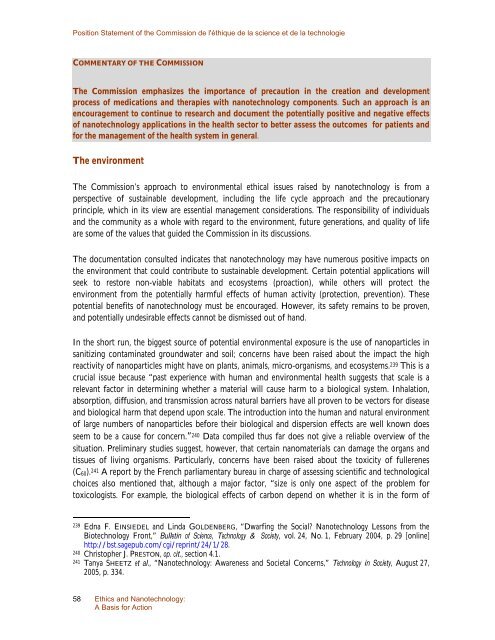A Basis for Action - Commission de l'éthique de la science et de la ...
A Basis for Action - Commission de l'éthique de la science et de la ...
A Basis for Action - Commission de l'éthique de la science et de la ...
You also want an ePaper? Increase the reach of your titles
YUMPU automatically turns print PDFs into web optimized ePapers that Google loves.
Position Statement of the <strong>Commission</strong> <strong>de</strong> l'éthique <strong>de</strong> <strong>la</strong> <strong>science</strong> <strong>et</strong> <strong>de</strong> <strong>la</strong> technologie<br />
COMMENTARY OF THE COMMISSION<br />
The <strong>Commission</strong> emphasizes the importance of precaution in the creation and <strong>de</strong>velopment<br />
process of medications and therapies with nanotechnology components. Such an approach is an<br />
encouragement to continue to research and document the potentially positive and negative effects<br />
of nanotechnology applications in the health sector to b<strong>et</strong>ter assess the outcomes <strong>for</strong> patients and<br />
<strong>for</strong> the management of the health system in general.<br />
The environment<br />
The <strong>Commission</strong>’s approach to environmental <strong>et</strong>hical issues raised by nanotechnology is from a<br />
perspective of sustainable <strong>de</strong>velopment, including the life cycle approach and the precautionary<br />
principle, which in its view are essential management consi<strong>de</strong>rations. The responsibility of individuals<br />
and the community as a whole with regard to the environment, future generations, and quality of life<br />
are some of the values that gui<strong>de</strong>d the <strong>Commission</strong> in its discussions.<br />
The documentation consulted indicates that nanotechnology may have numerous positive impacts on<br />
the environment that could contribute to sustainable <strong>de</strong>velopment. Certain potential applications will<br />
seek to restore non-viable habitats and ecosystems (proaction), while others will protect the<br />
environment from the potentially harmful effects of human activity (protection, prevention). These<br />
potential benefits of nanotechnology must be encouraged. However, its saf<strong>et</strong>y remains to be proven,<br />
and potentially un<strong>de</strong>sirable effects cannot be dismissed out of hand.<br />
In the short run, the biggest source of potential environmental exposure is the use of nanoparticles in<br />
sanitizing contaminated groundwater and soil; concerns have been raised about the impact the high<br />
reactivity of nanoparticles might have on p<strong>la</strong>nts, animals, micro-organisms, and ecosystems. 239 This is a<br />
crucial issue because “past experience with human and environmental health suggests that scale is a<br />
relevant factor in <strong>de</strong>termining wh<strong>et</strong>her a material will cause harm to a biological system. Inha<strong>la</strong>tion,<br />
absorption, diffusion, and transmission across natural barriers have all proven to be vectors <strong>for</strong> disease<br />
and biological harm that <strong>de</strong>pend upon scale. The introduction into the human and natural environment<br />
of <strong>la</strong>rge numbers of nanoparticles be<strong>for</strong>e their biological and dispersion effects are well known does<br />
seem to be a cause <strong>for</strong> concern.” 240 Data compiled thus far does not give a reliable overview of the<br />
situation. Preliminary studies suggest, however, that certain nanomaterials can damage the organs and<br />
tissues of living organisms. Particu<strong>la</strong>rly, concerns have been raised about the toxicity of fullerenes<br />
(C 60 ). 241 A report by the French parliamentary bureau in charge of assessing scientific and technological<br />
choices also mentioned that, although a major factor, “size is only one aspect of the problem <strong>for</strong><br />
toxicologists. For example, the biological effects of carbon <strong>de</strong>pend on wh<strong>et</strong>her it is in the <strong>for</strong>m of<br />
239 Edna F. EINSIEDEL and Linda GOLDENBERG, “Dwarfing the Social? Nanotechnology Lessons from the<br />
Biotechnology Front,” Bull<strong>et</strong>in of Science, Technology & Soci<strong>et</strong>y, vol. 24, No. 1, February 2004, p. 29 [online]<br />
http://bst.sagepub.com/cgi/reprint/24/1/28.<br />
240 Christopher J. PRESTON, op. cit., section 4.1.<br />
241 Tanya SHEETZ <strong>et</strong> al., “Nanotechnology: Awareness and Soci<strong>et</strong>al Concerns,” Technology in Soci<strong>et</strong>y, August 27,<br />
2005, p. 334.<br />
58 Ethics and Nanotechnology:<br />
A <strong>Basis</strong> <strong>for</strong> <strong>Action</strong>
















